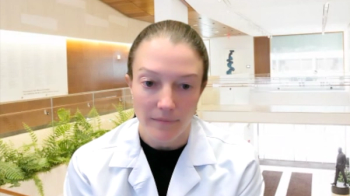
Combo Therapy More Than Doubled PFS in Platinum-Sensitive Recurrent Ovarian Cancer
The phase II AVANOVA trial examined PFS in advanced ovarian cancer patients who received a PARP inhibitor plus bevacizumab.
The combination of the PARP inhibitor niraparib plus bevacizumab significantly improved progression-free survival in women with platinum-sensitive recurrent ovarian cancer, according to results of the phase II AVANOVA trial (
Combination treatment more than doubled progression-free survival from 5.5 months with niraparib alone to 11.9 months with the combination therapy (hazard ratio [HR], 0.35; 95% CI, 0.21–0.57; P < .001), according to data presented by Mansoor R. Mirza, MD, of the Nordic Society of Gynecologic Oncology and Rigshospitalet, Copenhagen, Denmark.
Platinum-based chemotherapy is a standard treatment for platinum-sensitive recurrent ovarian cancer, but its use is limited by cumulative toxicity. Previous research established that maintenance with niraparib after platinum-based chemotherapy significantly improved progression-free survival.
AVANOVA was designed to test combination PARP inhibition and anti-angiogenesis as an alternative to platinum-based chemotherapy. This study included 97 patients with platinum-sensitive recurrent disease who were randomly assigned to niraparib 300 mg once daily alone, or niraparib 300 mg once daily plus bevacizumab 15 mg/kg every 3 weeks until disease progression.
Benefit was seen with combination treatment for patients with partially sensitive disease with a chemotherapy-free interval of 6 to 12 months (HR, 0.29; 95% CI, 0.14–0.62; P = .0006) and those with a chemotherapy-free interval of longer than 12 months (HR, 0.42; 95% CI, 0.20–0.80; P = .0062).
Homologous recombination-deficiency (HRD) status did not affect the efficacy of the treatment. Patients benefited from combination treatment regardless of HRD status (HRD positive: HR, 0.38; 95% CI, 0.20–0.72; P = .0019 vs HRD negative: HR, 0.40; 95% CI, 0.15–0.85; P = .0129).
Patients with BRCA wild-type disease also benefited from combination treatment (HR, 0.32; 95% CI, 0.17–0.58; P = .0001). However, because of the small number of patients with BRCA-mutated disease (33 patients), there was no significant difference in progression-free survival for patients treated with combination therapy compared with niraparib alone.
Overall response rate increased from 27% with monotherapy to 60% with combination treatment (odds ratio [OR], 4.23; 95% CI, 1.79–9.97; P = .001), and the disease control rate also increased with niraparib plus bevacizumab (53% vs 79%; OR, 3.36; 95% CI, 1.37–8.22; P= .008).
Overall, niraparib plus bevacizumab was well-tolerated, according to Mirza. Most patients were able to remain on therapy until disease progression, and no detrimental effect on quality of life was observed.
In his discussion of the results,
“No one discontinued treatment based on toxicities, but hypertension was far more common-and expected-with bevacizumab on board, and neutropenia risk was 12% [with the combination] vs 2%,” Dizon said. “Interestingly, these did not translate into any differential aspects of quality of life.”
Dizon said that as of ASCO 2019, clinicians can offer women with ovarian cancer options for treatment that do not include chemotherapy, but that future trials need to address other clinically relevant questions related to the use of PARP inhibitors.
Newsletter
Stay up to date on recent advances in the multidisciplinary approach to cancer.















































































